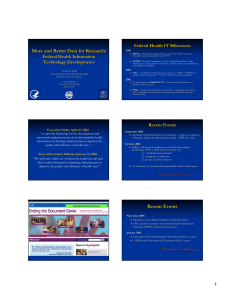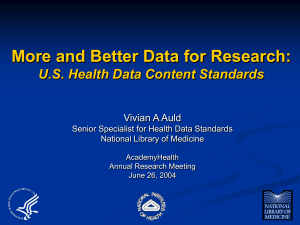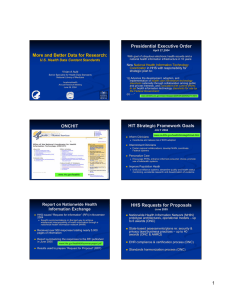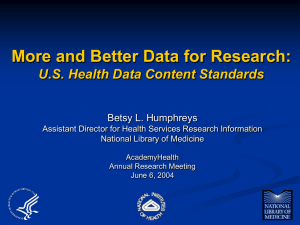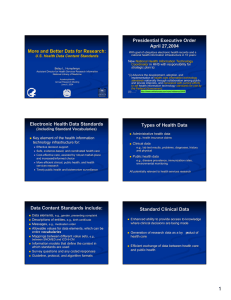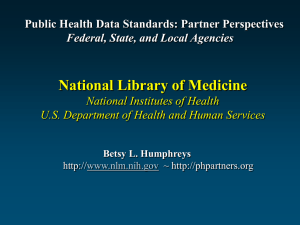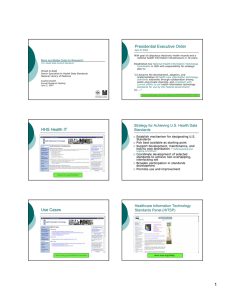More and Better Data for Research: Federal Health Information Technology Developments
advertisement
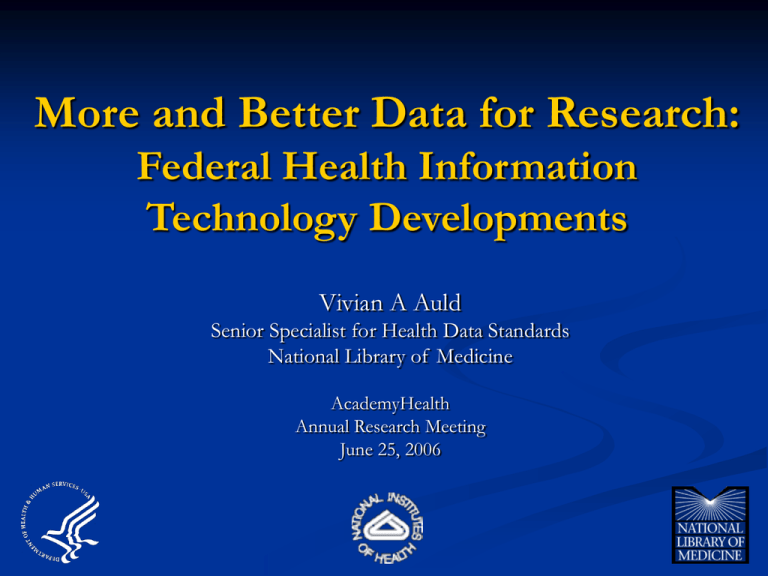
More and Better Data for Research: Federal Health Information Technology Developments Vivian A Auld Senior Specialist for Health Data Standards National Library of Medicine AcademyHealth Annual Research Meeting June 25, 2006 Federal Health IT Milestones 1996 HIPAA –Administrative Simplification section of Health Insurance Portability and Accountability Act of 1996 NCVHS - National Committee on Vital and Health Statistics, a longstanding (50+ years) advisory committee to HHS, which was strengthened and expanded by HIPAA 2001 CHI - Consolidated Health Informatics project, an HHS-VA-DOD eGov initiative which designated 1st U.S. gov’t-wide clinical data standards 2003 US-wide license for SNOMED CT - Systematized Nomenclature of Medicine Clinical Terms MMA – Medicare Modernization Act of 2003 – mandated e-prescribing and a time-limited Commission on Systemic Interoperability (JanuaryOctober 2005) Executive Order, April 27, 2004 “..to provide leadership for the development and nationwide implementation of an interoperable health information technology infrastructure to improve the quality and efficiency of health care…” State of the Union Address, January 31, 2006 “We will make wider use of electronic health records and other health information technology infrastructure to improve the quality and efficiency of health care.” Recent Events September 2005 American Health Information Community – advisory committee of industry leaders & federal agency heads – HHS Sec. chair October 2005 Office of National Coordinator for Health Information Technology (ONC), HHS awards contracts for (1) *standards harmonization (2) compliance certification (3) privacy/security solutions *Commission on Systemic Interoperability releases final report *NLM involved at HHS request Strategy for Adoption and endingthedocumentgame.gov/ Implementation of Standards Recent Events November 2005 Medicare e-prescribing foundation standards named ONC awards 4 contracts for National Health Information Network (NHIN) architecture prototypes January 2006 Interagency Health Information Technology Policy Council *HHS Health Information Technology Policy Council *NLM involved at HHS request The Community (AHIC) U.S. Gov’t ANSI Standards Selection and Coordination HIPAA - National Committee on Vital & Health Statistics , 1996 Consolidated Health Informatics eGov Project, 2002Medicare Modernization Act of 2003 ANSI Healthcare Info. Standards Planning Panel (HISPP) – 1991-1995 ANSI Healthcare Info. Standards Board (HISB) – 1996-2005 ANSI Healthcare Information Technology Standards Panel (HITSP), 2005•Established in response to HHS Request for Contract Proposals for: Sustainable Standards Harmonization Process, Cross-Standard Specs for Key Use Cases www.hhs.gov/healthinformationtechnology/ HHS Secretary Leavitt’s 500-Day Plan to Transform Health Care Systems Expressing a clear vision of health information technology that conveys the benefits to patients, providers and payers Convening national collaboration re: developing setting, and certifying HIT standards and outcomes for interoperability, privacy and data exchange Realizing the near-term benefits of health information technology in: adverse drug-incident reporting, e-prescribing, lab and claimssharing data, clinic registrations, insurance forms Creating an integrated network of population data, genetic information, and medical records to accelerate discovery Improving the clinical research network Providing early warning of threats through improved domestic and international surveillance Congress Drafting Health IT Bills www.himss.org/advocacy/cross_walk.asp ONC www.hhs.gov/healthit NLM HIT Standards Activities Support, license, develop, and distribute standard clinical vocabularies (LOINC, SNOMED, RxNorm) in UMLS *Distribute FDA-approved structured product labels via “Daily Med” *Direct efforts to map clinical terminologies to HIPAA administrative code sets *Direct contract to align HL7 with standard vocabularies and to define HL7 mechanism for exchange of entire EHRs Work with NIH to promote use of standards in the clinical research enterprise * Partially supported by funds from AHRQ and the Office of the Secretary, HHS Mapping Projects planned/underway CHI standards to HIPAA code sets SNOMED CT to “other” vocabularies Medical Dictionary for Regulatory Affairs (MedDRA) International Classification of Primary Care (ICPC) Medcin ICF Will require: SNOMED CT – ICD-9-CM, ICD-10-CM SNOMED CT – CPT LOINC – CPT Robust testing/validation Alignment of update schedules Draft mappings available for testing via the UMLS soon Key NLM Assumptions about Mappings Participants must include: Producers of vocabularies on both ends; prospective users and recipients of the output, e.g., health care providers, payers, as testers and validators Mapping may/will prompt changes/corrections to content and adjustment to update schedules Mappings must be updated every time either end is updated Mappings will be distributed in the UMLS (not exclusively); use will be governed by terms applicable to both ends Mapping is still an R & D problem - it will take iteration to build highly functional maps NLM- HL7 Contract Arrangement September 2004 – August 2007 Align HL7 message standard with standard vocabularies (NLM-initiated) Specify which subsets of standard vocabularies are valid for particular message segments Replace HL7-maintained lists of coded values with subsets of standard vocabularies, where feasible Conduct pilot transfer of EHR data using HL7 Messaging and Implementation guides independent of source and destination architectures (on behalf of HHS) Two NHIN prototype contractors participating in pilots Broaden participation: Clinical Research nihroadmap.nih.gov Resources for Researchers privacyruleandresearch.nih.gov Broaden participation: Public Health www.phdatastandards.info Take Home Messages Emphasis has shifted from health data standards to the broader picture of HIT and EHR. Will take time to put in place but ultimately will affect health care, public health functions, and the data available for HSR It’s not too early (or too late) to get involved: to contribute to standards development, testing, and refinement to study the impact of standards on health care, public health, and clinical research If you work with HIT investigate the use of the UMLS and other NLM resources at http://www.nlm.nih.gov
